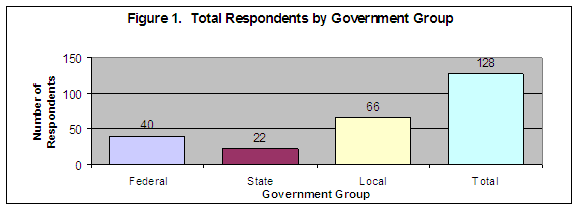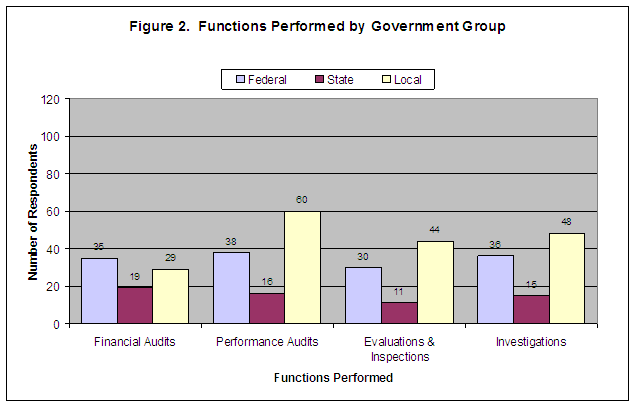Background and Purpose
Accountability is a key concept in promoting and safeguarding effective and efficient government operations. Government officials and citizens need to know that resources are used wisely to achieve intended results from government programs and services. Organizations such as offices of inspector general, audit groups, and other internal review groups play an important role in assisting government officials to be accountable to the public.3
Access to information is critical to these federal, state, and local accountability organizations performing audits, evaluations, inspections, and investigations. Because the quality of accountability work is dependent upon timely and complete information from organizations undergoing review, the Government Accountability Office’s Domestic Working Group surveyed selected accountability organizations nationwide to assess the nature and extent of information access problems encountered and the successful strategies employed to gain access. The Domestic Working Group is an informal group consisting of the Comptroller General of the United States and the heads of 18 federal, state, and local accountability organizations. A list of members is at Appendix I. With the assistance of the Government Accountability Office, the Department of Justice Office of the Inspector General (DOJ OIG) conducted the survey and compiled the results.
Scope and Methodology
Under the auspices of the Domestic Working Group, the DOJ OIG surveyed Federal Inspectors General, State Auditors, and the selected county and municipal accountability organizations regarding their experiences with information access problems through a web-based survey conducted from September 15 through October 21, 2005.
The survey was developed and pre-tested using representatives from federal, state, and local accountability organizations. The Government Accountability Office provided technical assistance to refine the survey, host the survey on its secure servers, and provide the survey responses at the end of the survey period.
The survey requested information from accountability organizations in the following areas:
-
Sources of legal authority and satisfaction with the authority,
-
Trends in access to information problems by functions performed:
-
Financial Audits: Financial audits are primarily concerned with providing reasonable assurance that financial statements are presented fairly in all material respects in conformance with auditing and accounting principles.
-
Performance Audits: Performance audits provide an independent assessment of the performance and management of a program. Performance audits can encompass a wide variety of objectives, including objectives related to assessing program effectiveness and results, economy and efficiency, internal controls, compliance with legal or other requirements.
-
Evaluations/Inspections: Evaluations and inspections provide an in-depth assessment of a major program, function, or activity or a concise assessment of a specific office, event, issue, or problem.
-
Investigations: Investigations examine allegations of violations of laws, regulations, and administrative procedures.
-
Factors affecting access to information, and
-
Successful strategies for resolving access to information problems.
The survey population of accountability organizations was compiled from the list of federal offices of inspector general on the Internet website of the President’s Council on Integrity and Efficiency; from the membership list of the National Association of State Auditors, Comptrollers, and Treasurers; and from the membership list of the National Association of Local Government Auditors. Representatives from the California State Auditor’s Office and the County of Milwaukee, Wisconsin, Auditor’s Office (both members of the Domestic Working Group) provided the state and local membership lists.
We sent the survey to the Government Accountability Office, 59 federal offices of inspector general, 64 state auditor offices, and 231 city and county accountability offices in 43 states.4 The heads of organizations in the survey population were sent an initial survey invitation when the survey was released on the web, followed by two reminder e-mails. Of the 355 surveys sent, we received completed surveys from 128 organizations: 40 of 60 federal organizations (67 percent), 22 of 64 state organizations (34 percent), and 66 of 231 local organizations (29 percent). Figures 1 and 2 show the number of respondents and functions performed by government group.
| Source: Survey responses to Question 1: Which of the following categories best describes your organization—Federal, State, or Local? |
| Source: Survey responses to Questions 9, 17, 25, and 33: Does your organization conduct financial audits? performance audits? evaluations/inspections? investigations? |
Table 1 shows by function the average number of reviews conducted annually by survey respondents.
Table 1. Average Number of Reviews Conducted Annually
by Survey Respondents
Financial Audits |
Performance |
Evaluations/ |
Investigations |
|
Federal |
28 |
56 |
19 |
228 |
State |
55 |
51 |
43 |
24 |
Local |
6 |
11 |
9 |
7 |
| Source: Survey responses to Questions 10, 18, 26, and 34: Annually how many financial audits, performance audits, evaluations/inspections, investigations does your organization complete? |
Respondents entered their data directly into the web survey. For any question, the survey respondent had the option of answering the question, indicating “No answer” (our data analyses excluded the “No answer” responses), or not answering the question at all. In other cases, a respondent was instructed to skip one or more questions depending on how a prior question was answered. Because of this, the actual number of respondents fluctuates slightly for each question. The Government Accountability Office converted the data into a database for analysis by the DOJ OIG. The detailed results of the closed-ended questions to the survey are contained in Appendix II.
Data Considerations
We did not project the survey results beyond the 128 organizations that responded to the survey. The results express only the opinions of the survey respondents. Further, the results represent the various response rates among the federal, state, and local organizations: federal 67 percent, state 34 percent, and local 29 percent. Where we combined federal, state, and local responses, the data represents these varying rates, which means that the federal response rate may be more representative than the state and local response rates. Also, many of the percentages presented in the report correspond to a small number of survey respondents. Lastly, the survey respondents are a variety of large, medium, and small accountability organizations with different workload levels for the functions they perform. These organizational variations can affect the meaning of the organizations’ responses. However, the scope of our survey did not include any analysis of the responses based on the size and workload of the organizations.
Government Auditing Standards, 2003 Revision, June 2003, General Accounting Office (now the Government Accountability Office).
The number of state auditor offices is greater than 50 because it includes the District of Columbia, Puerto Rico, and more than one accountability organization for some states as reflected on the membership list from the National Association of State Auditors, Comptrollers, and Treasurers.
Seven states did not have local accountability organizations on the membership list from the National Association of Local Government Auditors. We conducted an Internet search for major city and county accountability organizations within these states, but did not find any. Local governments may contract with private companies, such as auditing and accounting firms, to conduct accountability reviews of government operations. Also, some local governments may receive accountability oversight from state organizations such as state audit offices.

